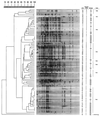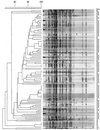Prevalence of Mycobacterium avium in slaughter pigs in The Netherlands and comparison of IS1245 restriction fragment length polymorphism patterns of porcine and human isolates
- PMID: 10203466
- PMCID: PMC84743
- DOI: 10.1128/JCM.37.5.1254-1259.1999
Prevalence of Mycobacterium avium in slaughter pigs in The Netherlands and comparison of IS1245 restriction fragment length polymorphism patterns of porcine and human isolates
Abstract
A significant increase in the incidence of caseous lesions in the lymph nodes of slaughter pigs prompted a large-scale investigation in five slaughterhouses in The Netherlands. In total, 158,763 pigs from 2,899 groups underwent gross examination. At least one pig with caseous lesions in the submaxillary and/or mesenteric lymph nodes was observed in each of 154 of the 2,899 groups examined (5%). In total, 856 pigs (0.5%) were affected. As many as five pigs in each of 141 of the 154 positive groups (91.5%) had lymph node lesions. Greater numbers of pigs with affected lymph nodes were found in 13 groups (8.5%). Four pigs had lesions in the kidneys, liver, or spleen. Acid-fast bacteria were detected by microscopic examination of 121 of 292 Ziehl-Neelsen-stained smears of caseous lesions (41%). In a follow-up study, Mycobacterium avium complex (MAC) bacteria were isolated from 219 of 402 affected lymph nodes (54.2%). Ninety-one of the isolated strains were analyzed by restriction fragment length polymorphism (RFLP) typing with insertion sequence IS1245 as a probe. All but 1 of these 91 strains contained IS1245 DNA, indicating that pigs in The Netherlands carried almost exclusively M. avium bacteria and no other bacteria of MAC. Only one pig isolate exhibited the bird-type RFLP pattern. MAC isolates from 191 human patients in The Netherlands in 1996 were also typed by RFLP analysis. Computer-assisted analysis showed that the RFLP patterns of 61% of the human isolates and 59% of the porcine isolates were at least 75% similar to the RFLP patterns of the other group of strains. This indicates that pigs may be an important vehicle for M. avium infections in humans or that pigs and humans share common sources of infection.
Figures


Similar articles
-
Impact of sawdust and wood shavings in bedding on pig tuberculous lesions in lymph nodes, and IS1245 RFLP analysis of Mycobacterium avium subsp. hominissuis of serotypes 6 and 8 isolated from pigs and environment.Vet Microbiol. 2004 Sep 8;102(3-4):227-36. doi: 10.1016/j.vetmic.2004.06.003. Vet Microbiol. 2004. PMID: 15327797
-
Molecular evidence to support a proposal to reserve the designation Mycobacterium avium subsp. avium for bird-type isolates and 'M. avium subsp. hominissuis' for the human/porcine type of M. avium.Int J Syst Evol Microbiol. 2002 Sep;52(Pt 5):1505-1518. doi: 10.1099/00207713-52-5-1505. Int J Syst Evol Microbiol. 2002. PMID: 12361252
-
High genetic relatedness among Mycobacterium avium strains isolated from pigs and humans revealed by comparative IS1245 RFLP analysis.Vet Microbiol. 2007 Nov 15;125(1-2):175-81. doi: 10.1016/j.vetmic.2007.05.005. Epub 2007 May 18. Vet Microbiol. 2007. PMID: 17590541
-
New probes used for IS1245 and IS1311 restriction fragment length polymorphism of Mycobacterium avium subsp. avium and Mycobacterium avium subsp. hominissuis isolates of human and animal origin in Norway.BMC Microbiol. 2007 Mar 5;7:14. doi: 10.1186/1471-2180-7-14. BMC Microbiol. 2007. PMID: 17335590 Free PMC article.
-
[Findings and ongoing research in the molecular epidemiology of tuberculosis].Kekkaku. 2009 Feb;84(2):83-9. Kekkaku. 2009. PMID: 19280913 Review. Japanese.
Cited by
-
Investigation of an outbreak of mycobacteriosis in pigs.BMC Vet Res. 2011 Oct 21;7:63. doi: 10.1186/1746-6148-7-63. BMC Vet Res. 2011. PMID: 22014189 Free PMC article.
-
Distribution of Mycobacterium avium complex isolates in tissue samples of pigs fed peat naturally contaminated with mycobacteria as a supplement.J Clin Microbiol. 2005 Mar;43(3):1261-8. doi: 10.1128/JCM.43.3.1261-1268.2005. J Clin Microbiol. 2005. PMID: 15750094 Free PMC article.
-
Characterization of a novel plasmid, pMAH135, from Mycobacterium avium subsp. hominissuis.PLoS One. 2015 Feb 11;10(2):e0117797. doi: 10.1371/journal.pone.0117797. eCollection 2015. PLoS One. 2015. PMID: 25671431 Free PMC article.
-
A comparative study of Mycobacterium avium subsp. avium and Mycobacterium avium subsp. hominissuis in experimentally infected pigs.BMC Vet Res. 2012 Jan 27;8:11. doi: 10.1186/1746-6148-8-11. BMC Vet Res. 2012. PMID: 22284630 Free PMC article.
-
Non-tuberculous mycobacteria isolated from slaughter pigs in Mubende district, Uganda.BMC Vet Res. 2012 May 7;8:52. doi: 10.1186/1746-6148-8-52. BMC Vet Res. 2012. PMID: 22564290 Free PMC article.
References
-
- Engel H W B, Berwald L G. A simplified agglutination test for serologic typing of mycobacteria. Am Rev Respir Dis. 1970;101:112–115. - PubMed
-
- Engel H W B, Groothuis D G, Wouda W, König C D W, Lenders L H M. ‘Pig-compost’ as a source of Mycobacterium avium infections in swine. Zentbl Vet Med B. 1977;25:373–382. - PubMed
Publication types
MeSH terms
LinkOut - more resources
Full Text Sources
Research Materials

